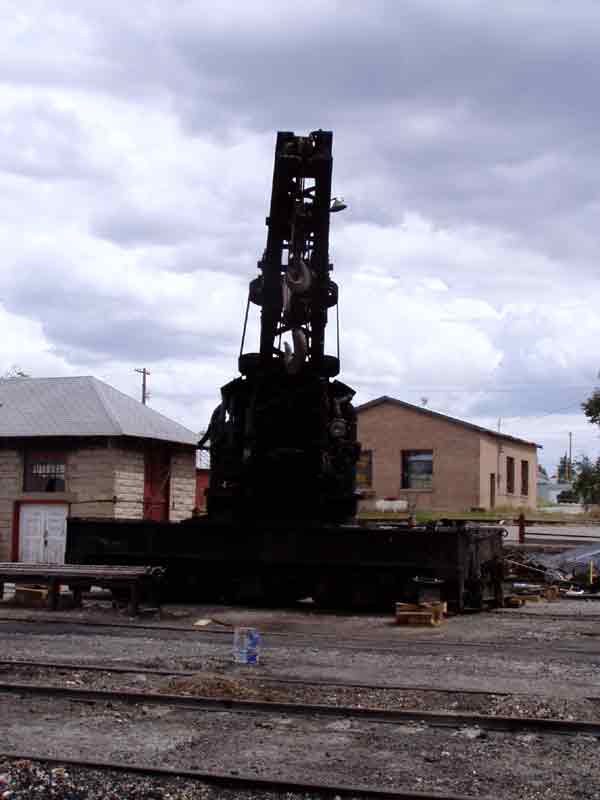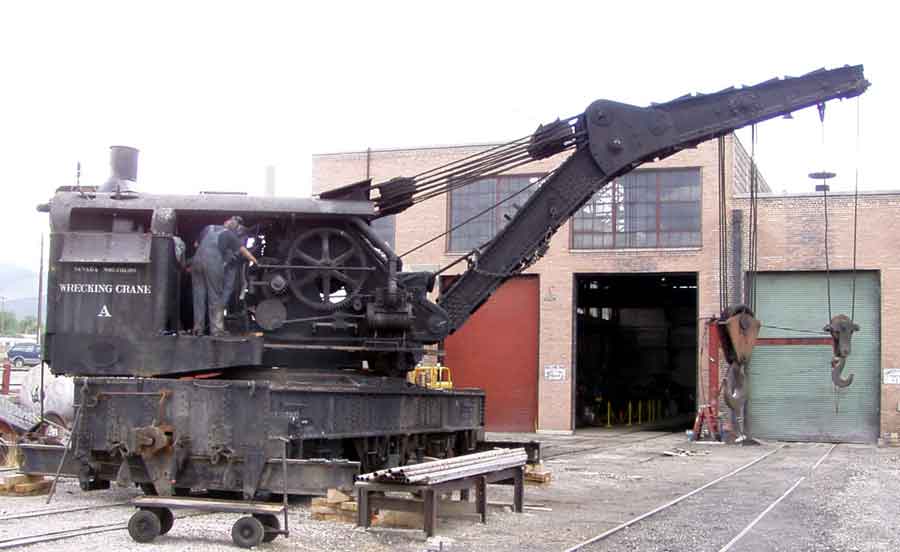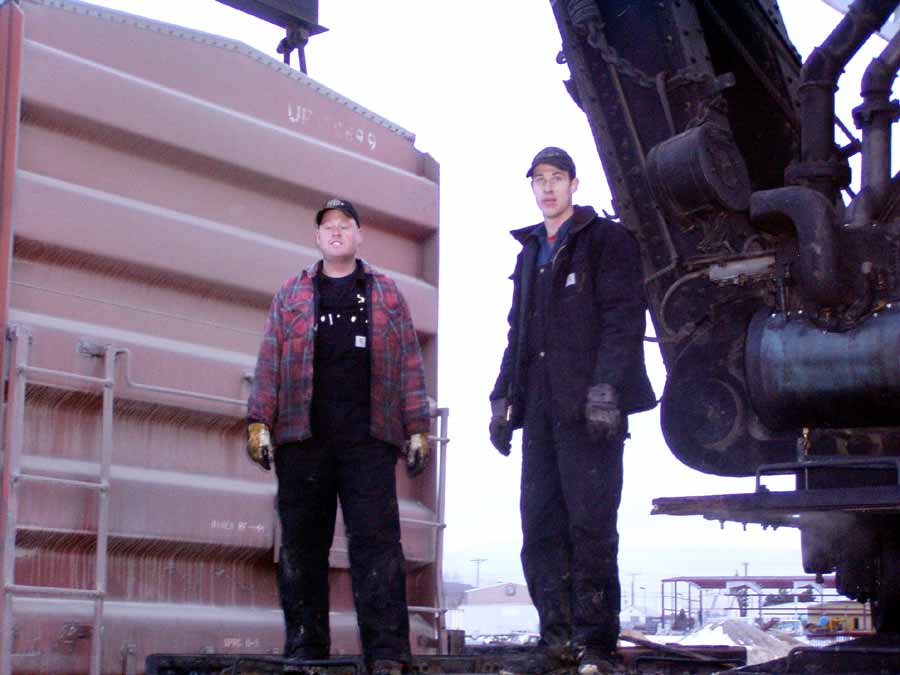August 8, 2005 was an exciting day at the museum. Our steam powered wrecking crane came back to life. The wizards in the mechanical department of the museum put Nevada Northern Railway, 100-ton steam wrecking crane ‘A’ back in service.
After the completion of the track from Cobre to Ely in 1906, the next move was to plan for operations. One of the tools required by any serious railroad would be a crane. The railroad purchased the crane new in 1907 from the Industrial Works of Bay City, Michigan for $16,015. Diesel and electric technology were in their infancy at the time. The technology that ruled the rails was steam. Hence, the 100-ton crane would be steam powered.
Referred to by railroad men as the “Big Hook,” the crane was used to lift rolling stock and locomotives back on to the rails after a derailment or wreck. Such cranes would also be used to lift heavy objects such as bridge beams. Crane ‘A’ was used in the building of the McGill Smelter. The crane was last used by the railroad in 1982 for a wreck on the Western Pacific.
Cranes are defined as “a rotating superstructure with power plant, operating machinery and boom, mounted on a base or car equipped for travel on railroad track…its function is to hoist and swing loads at various radii.”
Cranes are unique because they lift heavy objects vertically and shift them horizontally, making them distinct from hoists. The horizontal component is achieved by raising and lowering the boom. However, the center of mass must always remain within the footprint of the crane on the rails, or the crane will tip. As the boom is lowered, the center of mass moves away from the base of support. Careful counter weighting on the side opposite the crane’s boom exerts a torque about the center of mass opposing the torque exerted on the boom by the mass of the derailed locomotive or car. Hence, the center of mass is maintained over the narrow wheelbase and the crane does not tip over. For example, NN wrecking crane ‘A,’ with its steel outrigger beams extending from its base, has a 100-ton capacity at a radius of 17 feet; the capacity declines to 80-tons at a 23-foot radius. Capacity ratings are generally established at 80-85% of the load that produces tipping (when half of the wheels farthest from the load leave the rail) with the boom in the least stable direction relative to the mounting. With this in mind, it’s apparent that wreckers can lift a load in excess of their own total weight.
Since the management of the Nevada Northern in 1907 was farsighted enough to add a wreck crane to the railroad, it then became the responsibility of the museum to show how it works. For the crane to run again, money would be needed.
This project started with an application to TRAINS Magazine for a preservation grant. Like many artifacts from the early part of the last century, before this crane could be used in a responsible manner, hazardous materials would have to be removed (i.e. asbestos), the boiler would have to be checked and brought up to current code, and the crane would have to be gone through thoroughly before we could operate it.

The museum was awarded the second TRAINS magazine $10,000 Preservation Grant for the steam crane project. Plans were made to start the work in December 2000 and the project was scheduled for completion in January 2002. Work was actually started. The roof and boiler were removed along with plumbing.
That was the plan; the reality was that FRA boiler rules had changed and both steam locomotives 93 and 40 would need to be retubed. A review of museum priorities indicated that it was more important to retube the locomotives than to work on the crane.
Then the museum was invited to go the 2002 Olympic Winter Games in Salt Lake City. We brought along steam locomotive 93 with a couple of passenger cars to haul a worldwide audience to the Soldier Hollow venue.
The parts from the crane had been placed on a flatcar and pushed hither and yon. The parts appeared forlorn and abandoned. This is a museum’s worse nightmare—parts could start disappearing. The project was stalled.
In 2002, locomotive 93 was tubed and went over to the Olympics. In 2004, work began on locomotive 40 and it was brought back to service in February 2005. Now it was time to attack the steam crane project.
The money from TRAINS had been used to take the crane apart and remove the asbestos. Now in the spring of 2005, we were ready to do the crane but after completing locomotive 40 the money cupboard was bare.
It has been said, “Nothing succeeds like success.” Locomotive 40 is a beloved locomotive. Having it back in service impressed many people. A casual conversation led to the question, “How much would it take to finish the steam crane?” Good question. Head scratching and some rough calculations lead to the number $7,500 being bantered about. We doubled checked the figures and decided that, “Yes, it could be done for $7,500.”
Going back to the casual conversation, we declared that the steam crane would run again for $7,500. The answer, “Make it run again and I will donate the $7,500.”

We had our marching orders: finish the steam crane project. On a project like this time is of the essence. We had a donor who would underwrite the project, so we needed to get it done. Unfortunately, the offer came as we were about to enter our first season of daily steam trains. Time and resources would be stretched to the limit. To undertake this project we needed a secret weapon and we had one—Tuolumne Steam Locomotive Repair Company. Norman Comer, the proprietor, had assisted us with Locomotive 40. Norman was willing to help us with the crane. Time was of the essence. We had a limited budget. The project had to be completed quickly, on budget, and during our daily steam operations. It was beginning to sound like a TV reality show. And did I mention that the people who had taken it apart had all left and we had about a dozen 8″ x 10″ color photos that were water stained as a guide to help with the reassembly?
Norman’s attitude was the project was like a huge puzzle. Work from the edges towards the center and voilà, you have an operating steam crane.
Well it wasn’t quite that easy. The parts needed to be found and identified. More head scratching, testing, and discussing and it was time to start.


The boiler of the steam crane had been cleaned and tested. It passed its state inspection and was ready for installation into the crane body. But before the boiler could be installed, the crane body needed to ready for it, and the crane and boiler moved from the machine shop to the RIP building to use the overhead crane to place the boiler.
Success! The boiler was placed but not all of the boiler braces could be found. It was our worst nightmare. Pieces went missing in the four years since disassembly. With a limited budget and timeframe, it looked like we were dead in the water before we had started. But wonder of wonders, outside of the machine shop is a scrap steel pile and in the pile was the missing boiler brace. First crisis narrowly adverted.
The crane with the boiler now installed was moved back to the machine shop and Norman started to work on the fringes of the puzzle toward completion. In looking at the photographs, the plumbing was a nightmare. There was a feedwater pump plumbed into the system. Why was there a feedwater pump? Turns out, when the crane was last used in 1982, the operators of the crane did not know how to use injectors. Their solution was the feedwater pump.

Norman’s solution—out with the feedwater pump and in its place went two injectors. This simplified the plumbing and made for a neater installation. As the pieces started going together, the crane started looking more and more like its pictures. Soon there were very few parts left and it was time to install the roof and button it up.
It was time to do a test firing. The crane was towed outdoors. The boiler was full. Twenty-three year old coal was shoveled into the boiler. Wood was laid in on top followed by oily rags. Now all was ready. Norman had the honor of lighting the fusee and throwing it into the firebox. And . . . and . . . nothing much happened.
After all, this is steam driven piece of equipment. It takes a while to build a fire. Then, in turn, it takes time to build steam. And it does help when a fire has draft. We found the dampers and that made a world of difference.
As the fire was building, water leaks were discovered. This was expected. Pipes and fittings were tightened and leaks disappeared. Slowly the pressure rose. The needle slowly rose off the peg. Valves were checked. The injectors were checked. Higher the pressure rose until the safety valve lifted. With the safety and injectors working, now was the time to see if the machinery worked.
The steam crane has two steam cylinders just like a locomotive. Coming out of the cylinders are two rods, one for each side. These rods are connected to a wheel. The wheel converts the back and forth motion of the rods to circular motion, which can be used by the crane. These rods and wheels had not turned in twenty-three years. Would they work? Well there was no time like the present to find out. With the cylinder cocks wide open and lots of oil and grease spread on moving surfaces, it was time.
With no instruction or an instruction book, Norm and Jason traced steam lines and valves. With the theory down pat, it was time to open valves. Opening a valve on the main steam line, they were ready. Norm cracked the throttle. Dirty, rusty water flowed out of the cylinder cocks and the rods barely moved. Throttle closed. Everything is checked and oiled some more. Throttle opened. More rusty water and now steam comes out of the cylinder cocks. The rods move a little more and the wheels turn slightly. Throttle closed. Another check. More oiling.
Now it’s time. The throttle is opened again. More steam goes into the cylinders and the rods start to move with a jerking motion. Throttle closed. Everything is checked. The fire is good. The injectors work. Everything receives another coat of oil. Now it’s the moment of truth. The throttle is opened and steam rushes to the cylinders. Then it happens. The rusty water goes away; steam is coming out of the cylinder cocks. The rods are going back and forth, the wheels are turning, and everything is going as it should. Out come the cameras to record the moment.
We’re done for the day. The steam machinery and boiler are working fine. The next test will be the crane machinery. The fire is allowed to go down and the crane is pushed back into the machine shop.

| On Monday, little adjustments from the test run on Saturday are completed. The crane is pulled outside and the outriggers are extended and blocked. Now is the time, to see if everything works. A new fire is laid in the boiler. Steam comes up. Museum Chief Mechanical Officer Don Hepler, Shop helper Jason Lamb, and Norman are in the cab. It is tight. |
| Again, with no instruction book, Don, Jason, and Norman take the controls. Parts are oiled and moved to work the oil in. Steam is fed to the cylinders, the rods start to move, and the wheels are turning. It’s a little jerky at first and then everything settles down. The rods and the wheels are turning as smooth as silk. There is very little sound. | Click here for a short video clip of Steam Crane ‘A’ in operation. |
Don looks over the controls. It is now time to lower the big hook. A clutch is engaged and the four-foot diameter gear above the wheels starts to turn. The big hook starts to come down. Once the hook is on the ground, everything is lubed. The big hook is raised. Then the boom is lowered to remove the chains that secure it.
The crane body sits on a heavy-duty flat car. The crane can pivot on this car. The crane is supported by a series of heavy rollers. With the boom released from its securing chains, the crane is now free to pivot on the flat car. The rollers are lubed. Steam is allowed into the turning mechanism and slowly and majestically the crane starts to rotate on the flat car. Now perpendicular to the axis of the track, the big hook is lowered and raised again. After a few more tests to insure everything is lubed and in working order, the fire is allowed to go out and the crane is pushed back into the machine shop. The boiler plugs are pulled, and the water is drained out.
The next day the crane is pulled out again and taken to the RIP building where it is mated to its tool car, ‘A-1.’ Then the crane and tool car are pushed into the enginehouse with the stack of the crane under a smoke jacket, waiting to be called out again.
The museum learned from this project. This project proved the necessity of documenting the knowledge necessary for keeping the historic equipment in working order. The last time it was used, the injectors were replaced with a feedwater pump that was not necessary. The injectors were not used because the people at the time didn’t know how they worked. Now years later the crane is plumbed correctly.
In our excitement of getting the crane ready, there was talk of repainting the crane. Upon reflecting on the need to paint, it was decided not to. The current paint is serviceable. When coupled with tool car ‘A-1,’ it’s difficult to remember that you are in the 21st Century.
The crane is also an excellent example of why preservation is necessary. The era of the railroad crane is past. Crane ‘A’ is one of the few remaining cranes left in existence. Today, only about three of the remaining cranes operate. The history of railroading is reflected in the crane.
When Industrial Works started to manufacture cranes in 1893, they started with a 12-ton crane. As railroad technology improved locomotives became bigger and heavier. In eleven years crane size jumped to 100-tons. Four years after Crane ‘A’ was built, crane size jumped to 150-tons, and then in 1922 crane size jumped to 200-tons.
The Bay City, Michigan plant where ‘A’ was built is no more. It is now part of a riverfront reclamation project. But here in Ely, Nevada, there is a working remnant of the age that built America. Sitting in the enginehouse at East Ely is Nevada Northern Wrecking Crane ‘A’ and tool car ‘A-1.’ The coalbunker is full of coal. The crane is spotted under a smoke jack ready for the next call.
Nevada Northern Railway Wrecking Crane ‘A’ and tool car ‘A-1’ will be taken out of the enginehouse for special occasions. The first occasion will be the photo shoots in February 2006, then again during Long Steel Rails in June 2006, and for the October 2006 Photo Shoot.
Update—January 2006


We recently received two 50-foot boxcars that we will be using for storage. With the assistance of TRAINS magazine the crane is back in operation and two young men (Jason and Chris; see above right) are learning the skills necessary to operate our 99-year-old steam crane . . . and it’s accomplishing real work hoisting rolling stock. It’s also interesting that one of the people who helped with the unloading is our shop foreman, Al. His grandfather operated the crane. As the UP slogan on the boxcars indicates, “We can handle it.”

